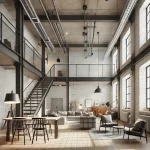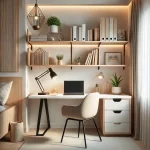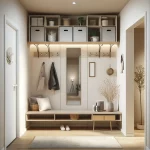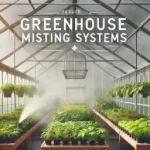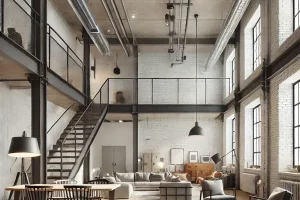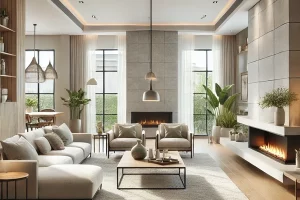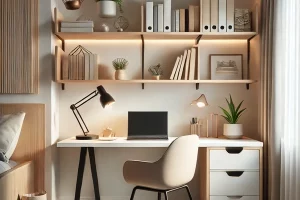Welcome to the world of passive solar greenhouses! If you love growing plants and care about our planet, this is for you. A passive solar greenhouse uses the sun’s power to help your plants grow. It’s a smart way to farm that saves you money and is good for Earth.
In this article, we’ll talk about all the cool things a passive solar greenhouse can do. We’ll look at how it helps you save money and why it’s good for the planet. We’ll also show you what to think about when you’re making one, like where to put it and what to use. And if you’re wondering how much it will cost, we’ve got that covered, too!
So, are you ready to learn about this amazing way to grow plants and help our planet? Let’s go!
What is a Passive Solar Greenhouse?
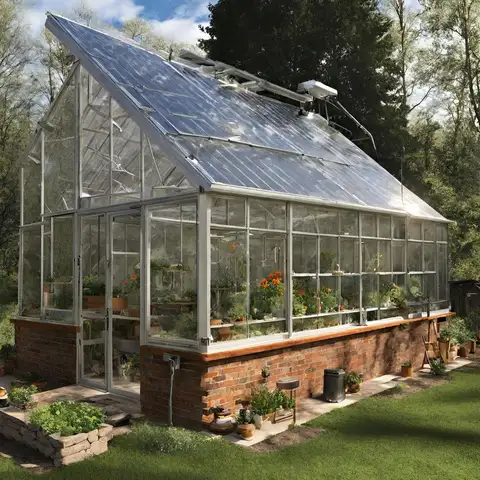
A Passive Solar Greenhouse is a special kind of greenhouse. It uses the sun’s power to keep plants warm and happy. It only needs a few extra heaters or fans like some other greenhouses.
Most regular greenhouses use machines to control heat and air. But a passive solar greenhouse is smarter. It uses the sun to warm it up and special materials to keep that warmth. It also has smart ways to let fresh air in when needed.
Advantages of Passive Solar Greenhouse
Energy efficiency
One big plus of passive solar heating is that it’s really good at saving energy. It uses the sun to keep your greenhouse warm. So, you don’t need to use extra electricity or gas. That’s a win for you and the planet!
Cost-effectiveness
Another cool thing is how money-smart it is. Once you set up your greenhouse the right way, you don’t have to spend much to keep it going. You won’t have big bills for heating, and that’s awesome!
Environmental benefits
The last big plus is that it’s earth-friendly. Using the sun’s power means you’re not adding to pollution. That’s a big deal these days when everyone is trying to be more green.
Disadvantages of Passive Solar Greenhouse
While passive solar heating has lots of perks, there are some disadvantages, too. Here are a couple of things to think about:
Initial Setup Cost
Setting up a passive solar greenhouse can be pricey at first. You’ll need to buy materials that hold heat well, and that can add up.
Geographic Limitations
Only some places are great for a passive solar greenhouse. If you live where there’s little sun, you won’t get the full benefits.
Best Passive Solar Greenhouse
When you’re on the hunt for the best passive solar greenhouse, there are some key things to keep in mind. These features will help you get the most out of the sun’s energy:
Sun Direction
Make sure your greenhouse faces the right way to get the most sun. In the Northern Hemisphere, that usually means facing south.
Glass or Plastic
Look for top-notch materials like polycarbonate panels. They keep heat in really well.
Heat Storage
Think about adding things like rocks or barrels of water. They can hold heat during the day and let it out at night.
Air Flow
Make sure there are enough vents or fans. It helps control how hot or humid it gets inside.
Keep the Heat
Check that the walls and roof are well-insulated. It helps keep the heat inside.
Strong Build
The greenhouse should be tough enough to stand up to all kinds of weather.
Top Recommendations
After looking at a lot of options, here are our top recommendations for passive solar greenhouses:
- SunTerra Greenhouse: Great for holding heat and keeping the cold out.
- EcoGarden House: This one has a built-in water plant system and strong airflow.
- SolarHarvest Greenhouse: Good quality and easy on the wallet.
- Harmony Greenhouse: Simple but gets the job done, especially with holding heat.
- SunKeeper Greenhouse: Easy to build yourself and doesn’t skip on the key features.
Passive Solar Greenhouse Cooling
Keeping your Passive Solar Greenhouse cool is important, especially in hot weather. Here are some ways to do it:
- Shade Cloth: Use a cloth to block some of the sun. It keeps the inside cooler.
- Roof Vents: Openings in the roof let hot air out.
- Side Vents: These let cool air in from the sides.
- Water Barrels: Filling barrels with water can absorb extra heat.
- Reflective Material: Using shiny material on the floor can bounce the sun’s rays back out.
Fresh air is key for plant health. Good ventilation helps in two ways:
- Temperature: It keeps the greenhouse from getting too hot.
- Air Flow: Fresh air helps plants grow better and keeps mold away.
Passive Solar Greenhouse Foundation
When building a Passive Solar Greenhouse, the foundation is a big deal. Here are some types you can use:
- Concrete Slab: This is a strong and stable option but can be costly.
- Wooden Frame: Less expensive than concrete but may only last for a short time.
- Gravel: Good for drainage but less stable than other options.
- Cinder Blocks: These are easy to use and provide good support.
- Natural Ground: Some people use the soil, but it’s not the best for keeping heat.
A good foundation does two main things:
- Stability: It keeps your greenhouse from falling over in bad weather.
- Insulation: A strong foundation helps keep the inside temperature steady.
Passive Solar Greenhouse Aquaponics
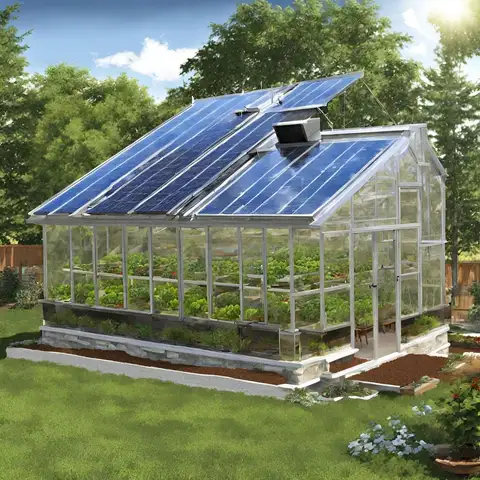
Aquaponics is a way to grow both fish and plants together. In a Passive Solar Greenhouse, this method can be super useful. The sun’s energy helps both the plants and the fish. It’s like a mini-ecosystem right in your greenhouse!
Benefits of Aquaponics
Here’s why aquaponics is a good match for a passive solar greenhouse:
- Energy Savings: The sun heats the water for the fish and gives light to the plants.
- Less Water: Aquaponics uses less water than traditional farming.
- No Chemicals: You don’t need to use harmful stuff to keep the plants or fish healthy.
- More Yield: You get both fish and plants to eat!
Challenges of Aquaponics
But it’s not all easy. Here are some challenges:
- Setup Cost: Getting all the tanks and systems can cost a bit.
- Learning Curve: You need to learn how to care for both plants and fish.
- Balance: Keeping the water right for the fish and plants can be tricky.
Passive Solar Greenhouse Design
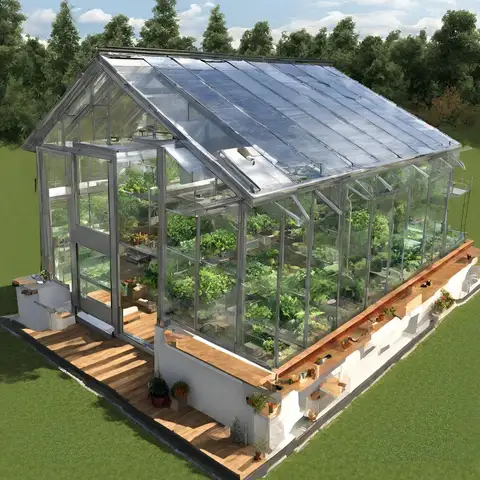
When you’re planning your Passive Solar Greenhouse, some design parts are super important. Let’s look at them:
- Orientation: Which way your greenhouse faces matters a lot. In most places, facing south gets the most sun.
- Glazing Material: This is the clear stuff the sun shines through. Good options are polycarbonate or glass.
- Thermal Mass: Things like water barrels or stone walls inside can store heat during the day and give it back at night.
- Insulation: Good insulation keeps the heat in. Think about insulating the north wall and the floor.
- Ventilation: Make sure you have windows or vents that can open to let hot air out.
Importance of Orientation and Materials
- Orientation: If your greenhouse faces the right way, you’ll get more sun. More sun means warmer temps and happier plants.
- Materials: The right materials can make a big difference. Good glazing lets in lots of light but only a little heat. And good insulation keeps that heat inside.
Passive Solar Greenhouse PDF
If you’re really into Passive Solar Greenhouses, you might want a guide or plan you can keep. Good news! There are PDFs you can download right to your computer or phone.
- Step-by-Step Guides: These PDFs walk you through the whole process, from picking a spot to putting on the roof.
- Material Lists: Some PDFs list all the stuff you’ll need so that you can get it all in one trip to the store.
- Design Plans: Want to know what your greenhouse will look like? Some PDFs have detailed drawings.
- Cost Estimates: If you’re on a budget, look for a PDF that tells you how much everything will cost.
Why PDFs Are Handy
- Portable: You can take them with you on your phone or tablet.
- Printable: Want a paper copy? Just hit print!
- Detailed: These guides go deep, so you’ll know just what to do.
Passive Solar Greenhouse Kit
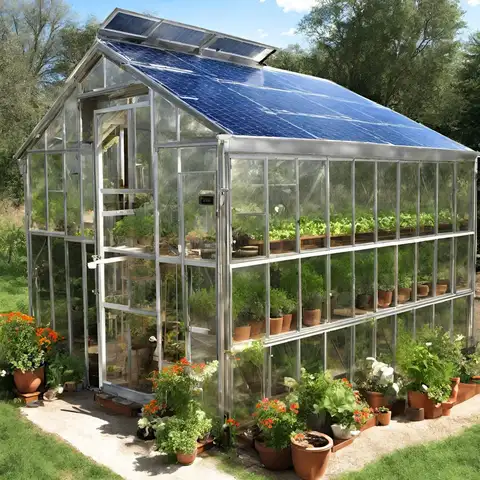
A Passive Solar Greenhouse Kit might be just what you need. These kits usually come with:
- Pre-cut Panels: These are the walls and roof, all ready to put up.
- Frame Pieces: Metal or wood pieces that hold your greenhouse together.
- Screws and Nails: No need to guess what you’ll need; it’s all in the box.
- Doors and Windows: Usually, these are pre-made, so you have to install them.
- Instructions: A guide that tells you how to put it all together.
Pros
- Easy to Build: With everything in the box, you can start building right away.
- Time-Saving: No need to run to the store for missing parts.
- No Special Skills Needed: If you can follow directions, you can build it.
Cons
- Cost: Kits can be more expensive than DIY.
- Less Customization: What you see is what you get. Changing things can be hard.
Passive Solar Greenhouse for Sale
Looking for a Passive Solar Greenhouse for Sale? You have a few options:
- Online Stores: Websites like Amazon, eBay, and specialized gardening sites often have a variety of options.
- Local Garden Centers: Check out your local garden shops. They might have just what you’re looking for.
- Direct from Manufacturers: Some companies sell directly to the public.
- Classified Ads: Sometimes, people sell used greenhouses in good condition.
Price Ranges
The cost can vary a lot, depending on what you’re looking for. Here’s a general idea:
- Basic Kits: These start at around $500.
- Mid-Range: Expect to pay between $1,000 and $3,000 for more features and better materials.
- High-End: These can go up to $10,000 or more, especially if they’re large or have special features.
DIY Passive Solar Greenhouse
Steps for Building Your Own
Building a DIY Passive Solar Greenhouse can be a rewarding project. Here’s how to do it:
Step 1: Plan Your Design
Sketch out your greenhouse design, keeping in mind the orientation for maximum sunlight.
Step 2: Gather Materials
You’ll need:
- Polycarbonate panels or other glazing material
- Wood or metal for the frame
- Screws and nails
- Insulating materials
- Stone or water barrels for thermal mass
Step 3: Prepare the Foundation
Lay down a strong foundation using concrete, gravel, or other suitable materials.
Step 4: Build the Frame
Construct the frame according to your design, making sure it’s sturdy and well-aligned.
Step 5: Install Glazing
Attach the polycarbonate panels or other glazing materials to the frame.
Step 6: Add Thermal Mass
Place stone or water barrels inside the greenhouse to store heat.
Step 7: Install Ventilation
Add vents or fans to help regulate temperature and humidity.
Step 8: Insulate
Insulate the walls and roof to minimize heat loss.
Step 9: Test
Before you start planting, test the greenhouse to make sure it maintains a stable temperature and humidity level.
Necessary Materials and Tools
Materials:
- Polycarbonate panels or other glazing material
- Wood or metal for the frame
- Screws and nails
- Insulating materials
- Stone or water barrels
Tools:
- Measuring tape
- Hammer
- Screwdriver
- Drill
- Saw
Passive Solar Greenhouse Cost
The cost of building a Passive Solar Greenhouse can vary greatly depending on its size and the features you want to include. Here are some rough estimates:
- Small greenhouse (8×10 feet): Around $500 to $1,000
- Medium greenhouse (12×16 feet): Approximately $1,500 to $3,000
- Large greenhouse (20×30 feet): Could be $4,000 to $8,000 or more
Additional Features:
- High-quality glazing material: $200 to $500 extra
- Advanced ventilation system: $100 to $300 extra
- Insulation: $150 to $400 extra
- Thermal mass elements: $50 to $200 extra
Tips for Budgeting
- Plan: Know the size and features you want so you can budget accordingly.
- Do It Yourself: Building the greenhouse yourself can save a lot of money.
- Reuse Materials: Consider using recycled or upcycled materials to cut costs.
- Shop Sales: Look for sales or discounts on materials and tools.
- Start Small: If you’re on a tight budget, start with a smaller greenhouse and expand later.
- Prioritize: Invest in essential features like good glazing and insulation before adding extras.
A Sun-Powered Greenhouse is a great idea! It uses the sun to keep plants warm and happy. It is good for you and good for Earth, too!
If you want to grow plants, think about a sun-powered greenhouse. It saves you money and is good for Earth. You don’t need lots of machines to keep it warm or cool. The sun does the work!
FAQs About Passive Solar Greenhouse
- What Is a Passive Solar Greenhouse?
A passive solar greenhouse uses the sun’s energy to keep plants warm and help them grow. It doesn’t need extra heaters or fans.
- How Does It Save Money?
Because it uses the sun’s energy, you don’t have to pay for extra heat or cooling. It saves you money on your bills.
- Is It Hard to Build?
No, it’s not too hard. You can even find kits that make it easier. But you should plan carefully to get the most sun power.
- Can I Use It All Year?
Yes, you can! The greenhouse keeps plants warm in winter and cool in summer. But you should add some shade or vents for very hot days.
- What Kind of Plants Can I Grow?
You can grow many kinds of plants, like veggies, herbs, and flowers. Just make sure they like the same kind of weather.
- Do I Need Special Glass?
It’s good to use special panels that keep heat in. They might cost a bit more, but they save you money later.
- What If I Need More Space?
That’s okay! You can build a small passive solar greenhouse, too. It will still help you save money and be kind to Earth.
- Where Should I Put My Greenhouse?
Place it where it will get lots of sun, usually facing south if you live in the Northern Hemisphere.
- Do I Need to Water the Plants More?
Not really. Just water like you usually do. But always check the soil to make sure.
- Can I Add Fish or a Pond?
Yes, some people add a small pond or fish tank. It is called “aquaponics,” and it can make your greenhouse even better.
